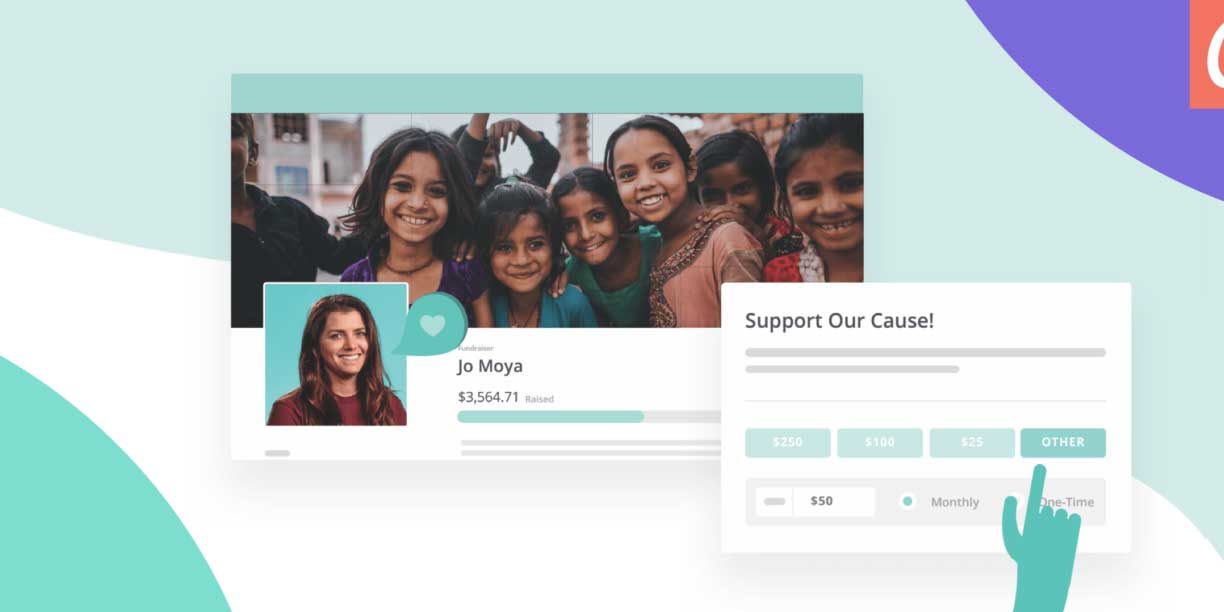How to Maximize Peer-to-Peer Fundraiser Retention and Raise More Money

Request a Demo
Learn how top nonprofits use Classy to power their fundraising.
In The State of Modern Philanthropy 2019, we found that return peer-to-peer fundraisers typically raise over twice as much as one-time peer-to-peer fundraisers. Not only that, they’re nearly three times more valuable than a one-time donor.
Already a Classy Customer?
Sign Up for Peer-to-Peer Coaching
Yet, only 14% of peer-to-peer fundraisers return to fundraise again. Given these findings, it’s crucial that you engage and nurture peer-to-peer fundraisers with as much zeal as you would major donors or recurring givers. This is doubly important when you consider the value of your fundraisers goes well beyond financial return.
Peer-to-peer fundraisers can typically raise more money for your nonprofit than they would be able to donate out of pocket. They also evangelize your brand to the public and introduce new audiences to your organization.
To ensure your peer-to-peer fundraiser retention efforts are successful, consider a multi-pronged approach that:
- Coaches first-time fundraisers
- Maintains consistent and engaging touchpoints with all fundraisers
- Identifies and activates those who have successfully fundraised on your behalf before
- Provides a delightful fundraising experience for all
- Explicitly asks fundraisers to return and stay involved
Segment and Build Stronger Relationships
First, let’s be clear in our definitions. By “fundraiser,” we mean an individual who creates a personal fundraising page for your peer-to-peer fundraising campaign. In order to successfully retain them, drill down into your peer-to-peer fundraisers and segment them into a few tiers.
Identify your most enthusiastic, dedicated, and successful fundraisers from previous campaigns. When it comes to building a positive fundraiser experience, this segment of powerhouse fundraisers should get a white-glove, one-on-one relationship with your nonprofit.
In an ideal world, you would provide this level of service to everyone, but that may not be feasible given your staffing bandwidth or time. So, take your past peer-to-peer fundraisers that don’t fit into this bucket and put them into a separate, more general one.
It’s still important you provide an engaging experience for this general tier, but it probably doesn’t need to be hands-on like your powerhouse tier. Instead, focus on automated digital tools that can assist, like social media and email marketing platforms.
Finally, create another segment that focuses on your first-time fundraisers. You’ll likely need to send them introductory materials and resources that might not be as relevant for your other two segments, like tip sheets for beginners. Once the campaign ends you can bucket first-timers into one of your other two segments.
While each segment requires a different touch and approach, the common thread uniting them all is how they enable you to build relationships with your fundraisers. If you want supporters to come back to your future campaigns, you have to know them: they’re more than a transaction.
Overcome Obstacles, Together
Both first-time and return fundraisers might run into issues, which underscores the need to go the extra mile for them. For example, a common question you may run in to is: “I’ve started my personal fundraising page and emailed my network. Now what do I do?”
Take the time to step up and coach your fundraisers, whether it’s through one-on-one meetings or digital means. Here are a few common roadblocks and how you can work through, together:
The Obstacle: Time
People have busy lives and fundraising on behalf of your nonprofit isn’t their primary job. Sometimes it can get lost in the shuffle or pushed to the back burner.
The Answer: Share insights and trends you’ve noticed with previous fundraisers in similar situations. For example, maybe you know that once a fundraiser hits 80% of their goal, it only takes three more emails to a group of 20 people to hit the mark. Send them resources that can help, like any email templates or tip sheets. Finally, set up small milestone celebrations as they work to capture that last 20% so the goal feels more attainable.
The Obstacle: Lack of Confidence
Creating a personal fundraising page and sending it out into the world can make people feel vulnerable. If there’s not an immediate outpouring of support, fundraisers may pull back with diminished confidence.
The Answer: Remind your fundraisers that what they’re experiencing is completely normal and it’s OK to feel uncomfortable throughout this process. Take the spotlight off the negatives and shine it brightly on the positives. Even if they’ve only received $10, celebrate their victories in any capacity, because even the smallest donation is making a difference, and it’s because of them.
The Obstacle: Lack of Network
Your fundraisers might not think they have an extensive personal or professional network. When it comes to soliciting for donations, this perceived lack of network can deter momentum.
The Answer: Show fundraisers how to think outside the box and look beyond their immediate or environment. For example, what partnership opportunities with local community groups, like churches or schools, can they tap? Remind them that they don’t need 1,000 friends to fundraise successfully. All they need is an audience of people who care about your nonprofit’s mission like they do. Let them know they can use their personal page as a way to introduce themselves to new groups of people and have them encourage the donors to their page to share with their networks.
Follow-Up and Re-Engage
When your peer-to-peer fundraising campaign ends, your stewardship work begins. First and foremost, you need to thank all segments for their hard work, celebrate their milestones, and highlight the impact they’re going to make possible for your organization.
Treat this as an opportunity to take your relationship with each fundraiser to the next level. If the “thank you” is the first touch point, your second touch point might be messaging that showcases the direct impact their fundraising efforts is going to make possible for your nonprofit, beneficiaries, and programs.
You can get creative with other kinds of communications and invite peer-to-peer fundraisers to:
- Connect on social
- Subscribe to newsletter
- Register as a volunteer
- Share a campaign to their networks
You should consider surveying your fundraisers to develop a better understand of their interests and motivations. This tactic would allow you to send even further targeted messaging as you continue your relationship and invite them back to get involved again.
Get 100 Free Questions for Your Next Donor Survey
Remember, your goal here is to provide a great experience for your fundraisers so they want to come back to fundraise again and raise even more money. But that can’t happen if you don’t provide an excellent experience and continue to develop your relationship and ask them back.
For example, consider fun ways you might help keep your relationship alive. You could highlight your fundraisers on Instagram stories. Tag first-timers who got creative with their pages or return fundraisers who exceeded their goals.
Consider giving them shout outs in email newsletters or send special email appeals that align with programs they support. Do anything you can to cement these fundraisers into the bedrock of your nonprofit: they could become a strong foundation from which you can build for years to come.
The overall experience you provide has a massive impact on peer-to-peer fundraiser retention and encourages them to return for future campaigns. If you want to maximize their financial potential, invest the time to coach them, equip them with the proper resources, and build meaningful relationships with them.
Make sure to download The State of Modern Philanthropy 2019 to dig into even more insights around return donor behavior like this. Get your free copy below.

The State of Modern Philanthropy
Subscribe to the Classy Blog
Get the latest fundraising tips, trends, and ideas in your inbox.
Thank you for subscribing
You signed up for emails from Classy
Request a Demo
Learn how top nonprofits use Classy to power their fundraising.
 Explore Classy.org
Explore Classy.org 

